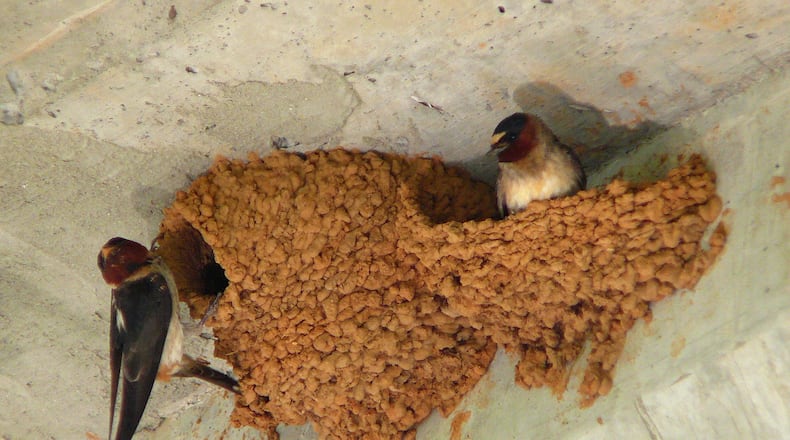With spring migration all but over, songbirds are super busy now with building new nests, fixing up old nests and laying eggs. Most of the nests are composed of common, everyday bird-nest materials — twigs, straw, grasses, rootlets, pine needles, animal fur, moss and the like.
Many birds, though, use additional materials. In particular, some birds have a fondness for mud, spiderwebs and snake skins to make their nests strong, safe and flexible.
Mud-using birds employ that mucky substance to strengthen their nests. The Eastern phoebe, which is fond of nesting under house eaves, makes a nest with a solid mud base built up with moss, leaves and grass and lined with fine grass and animal hair. The American robin’s sturdy cup nest is made of grass, moss and loose bark, all cemented together with thick mud that the bird transports in its beak.
Some species’ nests are primarily made of mud. The cliff swallow, which often nests in large colonies under bridges, overpasses and culverts in North Georgia, is the master mason of the bird world. Cliff swallows mix mud with their saliva to make pellets for their gourd-shaped nests. They deposit the well-formed pellets onto other mud pellets, which bond together and harden into a strong nest wall. A finished nest may contain more than a thousand mud pellets.
Spiderwebs are important for the nests of ruby-throated hummingbirds, blue-gray gnatcatchers, indigo buntings, American goldfinches, some warblers and others. Strands of spider silk are strong, sticky and stretchy. The birds mostly use the strands to bind together a combination of twigs and grass for their nests. Spider silk not only acts like Super Glue, holding everything together, but it’s stretchy enough to accommodate the growing bodies of nestlings.
Snake skins might seem like strange nesting materials, but some birds such as blue grosbeaks, great crested flycatchers and tufted titmice find them useful. Snake skins incorporated into bird nests, it’s believed, may deter predators such as black rat snakes and flying squirrels from preying on eggs and nestlings.
IN THE SKY: From David Dundee, Tellus Science Museum astronomer: The moon will be last quarter on Thursday. Mercury and Mars are in the east just before sunrise. Saturn is in the west just after dark and will appear near the moon on Thursday night. Jupiter and Venus aren’t easily seen right now.
Charles Seabrook can be reached at charles.seabrook@yahoo.com.
About the Author
Keep Reading
The Latest
Featured


